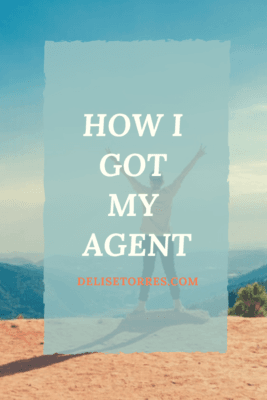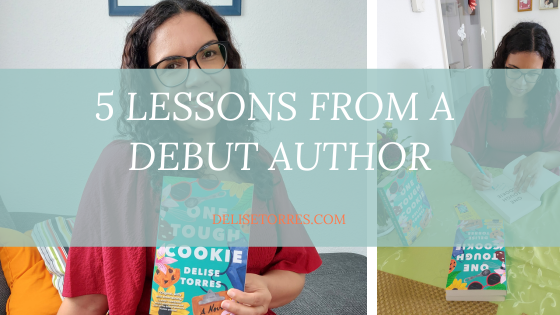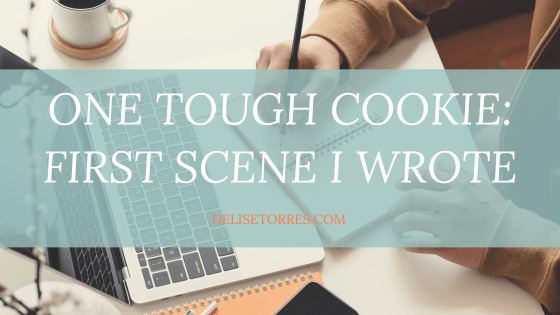I’ve read so many of these posts and now I finally get to write one! Here’s the story of how I got my agent, plus helpful tips for writers in the query trenches.
My Writing Journey
The story of how I got my agent starts with how I started writing. I’d never considered being a writer, but I loved to read and was always good at writing essays (nothing creative). It wasn’t until I moved to Germany in 2012 and faced unemployment that I finally sat down and wrote one of the daydreams I always carried in my head. This turned into my first novel, PULLING ME BACK IN, which I finished in 2016.
I queried and got no requests. I realized I had to revise the opening pages, but depression and pregnancy kept me stagnant. In January 2018, I finally sat down and revised it, determined to make it work. This time, I got a full request! I thought, “This is it!” But it wasn’t. tThere were no other requests, and the agent who requested said she didn’t know how to sell it. I had to shelve it and start over.
Luckily, I had two ideas brewing and chose the one I thought had the most potential. It was set in a cookie manufacturing plant. With my education in Food Science, I could design the company and the products. I could use my former work experience as a quality assurance manager as inspiration. And the characters would be Puerto Rican, so I could add a bit of my culture. I titled this novel, THE SINGULARITY OF COOKIES, and finished the first draft in February 2019.
Pitching
Fast forward to September 2020, when I participated in a pitch workshop hosted by the Women’s Fiction Writer’s Association (WFWA). Members are grouped and share their pitches for critique. I got great feedback for my 50-word pitch and got ideas for a better hook I could use for my query. At the end of February 2021, I sent my almost-final draft to beta readers and though I still wanted to do one final polishing, I decided to participate in #PitMad on March 4th, refurbishing the pitch I already had to fit on Twitter. I ended up getting three likes from agents, more than I ever got when I pitched my previous book. I knew I was on the right track, but I still needed to finish revising my novel.
At around the same time, the WFWA was hosting an Agent Pitch Event, where you post your 50-word pitch and the first 500 words for agents to read. I submitted my entry and rushed to finish. The first week of the event, I got two requests! I was so excited; I knew this book would be the one that finally got me an agent.
Querying
On March 29th, I sent the requests from both events and started querying. Right away, I got two full requests and one partial. I continued sending out queries.
By April 15th, I had sent thirty queries and had gotten another full request and another partial. That day, I got a rejection on my first partial. The agent mentioned that my story premise was “intriguing”, my writing “strong and engaging,” but that she didn’t love it as much as she’d need to for offering representation. I spent the weekend researching more agents to query to increase my chances for a yes, and on Monday, April 19th I sent nine additional queries.
Up to that point, the responses had been very slow, way longer than on my previous trip to the query trenches. On Friday April 23d, I reviewed the agents’ query response times on Query Tracker. They were all over the place. It was going to take time, and I needed to be patient. I told my husband I wouldn’t obsess anymore.
The Offer
That afternoon, I was playing UNO with my three-year-old daughter when my phone beeped with a notification. I’d been jumping every time my phone beeped, so when we finished one round, I got up to check. There was an email from Lindsay Guzzardo, an agent who’d requested the full manuscript a week before. I read it. She said she would be “thrilled to offer representation.” I was shocked.
I went back to continue playing UNO.
My husband was out doing groceries, so I told my daughter, “Mommy go an agent.” She didn’t care and only wanted to keep playing. Thankfully, my husband returned a few minutes later, and I ran to the door to tell him the news. Then we continued playing UNO until I finally snapped out of my shock and went to my laptop to send an answer to the agent.
We set up a call for the coming Monday. I emailed the agents who hadn’t responded, giving them until May 3rd to respond. A flurry of congratulations and requests followed. It was unreal.
The Call
Lindsay was really easy to talk to, very nice and friendly. She said she loved my voice, the title of the book, and the unique setting of the cookie plant. Plus, she didn’t see any major revisions for the book and thought it fit well in the Women’s Fiction genre (I’d been worried she’d ask me to make it fit more toward Romance, which would’ve meant major revisions). When asked what editors she wanted to submit to, she mentioned my dream publisher. I was sold!
But first I had to wait for the other agents. Though I was excited to work with Lindsay, I wanted to take the process to the end. I got eight additional full requests during this time. That week, the waiting was the worst. Rejections started pouring in, but I appreciated the heartfelt messages the agents sent, wishing me luck in my career, telling me they looked forward to seeing the book deal announcement and my name in bookstores.
And now I can officially say I’m represented by Lindsay Guzzardo at Martin Literary Management.
Final Query Stats:
Queries Sent: 39
Positive Replies: 13 (33% request rate)
Total Time Querying (from first query sent to offer received): 25 days
How I Queried
For those who want to know how I actually went about querying, read on.
1. Research agents to query and compile a list
I wanted to only query agents who represented both Women’s Fiction and Romance, since my novel overlaps the two. First, I searched on Manuscript Wish List for terms like “food” and “baking” to target those agents who were looking for books with those elements. I also searched for my comps. For example, I found some agents whose favorite TV show was “Fleabag.” Then I double checked their info on their agency’s website.
I started compiling my list once I had a finished draft, and once I was ready to query, I subscribed to Publisher’s Marketplace to verify what the agents had actually sold. With this information, I had a curated list with agents I’d be happy to work with.
2. Rank agents by preference
I ranked the agents based on their wishlists and the books they’d sold. Group 1 had agents I thought would be the best fit. Group 2 was middle ground and Group 3 consisted of agents I’d love to work with but who I wasn’t sure if they’d like the novel, either because their wishlists weren’t as specific or they had sold nothing similar.
3. Prepare your materials
Make sure to get critiques on your query and synopsis. I worked on mine as I wrote the novel and multiple people critiqued it.
I also recommend you prepare separate files for the sample pages – First 5, First 10, First 20, etc. Most agents expect this to be pasted in the body of the email, so I prepared these pages single-spaced. Some wanted them attached, so I kept these double-spaced. Make sure you follow the submission guidelines on the agency’s website.
I like to prepare a Word document for each agent, where I include the query and whatever else they request. This keeps me organized, and if I don’t want to send them right away, I can work on them here before I paste it into the email.
4. Send queries
Since I knew my pitch worked, I started querying Group 1 first, consisting of ten agents. With this group, I had the highest request rate (70%). Group 2 (where Lindsay was) was larger, with a request rate of 29%. I got no requests from agents in Group 3.
I prepared the submission package and sent it as I went. That first week, I sent all queries to Group 1, and got three requests. I knew I was on the right track and was confident that my novel was ready. So the next week, I sent queries to all the agents on my list (thirty total).
5. If you get an offer, don’t accept right away
I asked Lindsay for a deadline, and she gave me ten days to respond. Since I got my offer via email, I was able to digest the news and prepare the questions I wanted to ask beforehand. I also used this time to interview one of her clients.
Always let the other agents know about your offer, and either remove your query from consideration or give them a chance to request, read, and maybe counter-offer. Since I hadn’t heard from most agents and my list had been curated, I gave them all a chance to respond.
My advice to increase your chances of success:
1. Be strategic in what you write
You should always write what you love, but you should also write what can sell. With my first novel, I didn’t know what I was doing, and I realize now the story is a bit outdated. The characters are white and privileged, and there was nothing about me in the book. With TSOC, I could include my culture and my education to create a killer bio that could attract agents.
Also, read in your genre, especially recent books and debuts. That way you know what is selling and what topics haven’t been done to death. I knew my novel was unique and could compete in today’s market. Reading also helps you with the comps, which is useful for showing agents you know the market and where your book fits in.
2. Make sure your novel is ready
It took me two-and-a-half years to finish this book. Once you get subjective feedback on things you can’t really fix without changing your whole story, you know it’s done.
3. Target the agents
As you saw above, I got the highest request rate from Group 1, who I thought would be the best fit. Do your research and curate your list.
If you want more, check out my post on lessons I learned while querying my first novel.
I hope my post inspires you to keep going and gives you more insight on querying. Let me know if you have any questions below.









